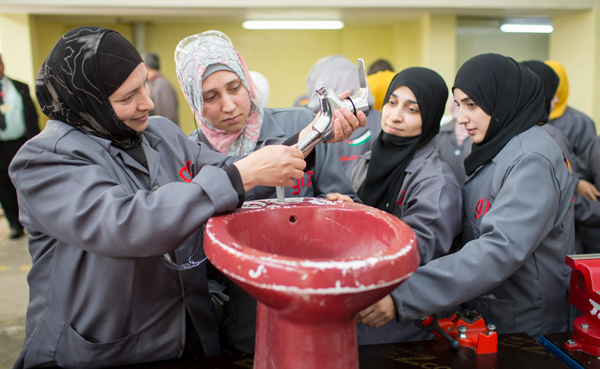 The Jordanian Government has placed tremendous emphasis on reforming the TVET sector in the country in an effort to bridge the gap between education and employment and to equip young Jordanians with skills that are needed in the labor market (UNESCO, 2019). Towards that end, several national policies and strategies reflect the Government’s determination to reform the TVET sector, however, there are several well-documented challenges that face the TVET system which could be summarized as follows:
The Jordanian Government has placed tremendous emphasis on reforming the TVET sector in the country in an effort to bridge the gap between education and employment and to equip young Jordanians with skills that are needed in the labor market (UNESCO, 2019). Towards that end, several national policies and strategies reflect the Government’s determination to reform the TVET sector, however, there are several well-documented challenges that face the TVET system which could be summarized as follows:
1- Fragmentation:
In Jordan, there are a number of players involved in the TVET sector, resulting in a somewhat disintegrated and distorted ecosystem that made the TVET sector fragmented in its organization and vision. Albeit the establishment of TVSDC, the sector is characterized by institutional rivalry, and not by cooperation and coherence. Additionally, there are multiple institutions with overlapping mandates and lack of clear leadership for planning, implementation, coordination, and monitoring.
2- Low involvement of the Private Sector in TVET Programs:
Because of recognized differences between employers and training providers, the private sector in Jordan continues to exhibit little interest in cooperating with TVET providers. This is partly because companies in the private sector in Jordan are still “mercantilist”, concerned with short-term business gains and productivity, the latter largely driven by their limited size and short-term vision/orientation. According to these companies’ view, involvement in the design and implementation of the training programmes and in the internship/apprenticeship components would require extra “unproductive” efforts and pose a heavy financial burden on the private sector employer and thus see little to no value in taking part.
3- Shortage of data and information:
TVET stakeholders in Jordan continue to endure difficulties from the lack of readily available labour market data that can be analysed to generate useful and informed policy discussions. At the present time, current statistics on the labour market in Jordan are produced by the Department of Statistics (the quarterly “Employment and Unemployment Survey”), the National Centre for Human Resource Development, as well as other government and non-government sources. However, these continue to be irregular, questionable in accuracy and quite limited in scope. Needless to say, up to date labour market information is a critical element in identifying labour market priorities as a basis for the development of TVET programs.
As of today, there is no fully-fledged functioning instrument of tracing TVET graduates after they finish their courses. In theory, the TVET system is supposed to produce a qualified workforce that would be employable and marketable in the labour market. However, at this time, the TVET system in Jordan does not have an efficient response mechanism that precisely points to the real employment rate of TVET graduates. The end result is that the TVET system in Jordan is unable to plot for matching the provided programs to the actual employment opportunities in the labour market.
4- lack of sustainable financial resources and effective investment:
The low portion of finance allocated to the human resource sectors such as education and training, along with a poor targeting of these resources, are major obstacles that hinder all reform plans. Given the limited financial resources available only few are available to cover developmental expenses such as new initiatives, teaching and learning materials and other inputs and programmes to address quality problems. Financial and investment management is one of the weakest features of the TVET system, including under-developed regulations on resource utilization including the lack of incentives for performance; and the application of result-based funding for TVET.
5- Quality is poor to moderate at all levels:
As a result of the previous four points, TVET quality is poor to moderate at all levels which created public prejudice against the TVET provisions. Jordan does not have national occupational standards per se, curricula are outdated, trainers need capacity building, and the facilities, equipment and tools are very poor.
On the other hand, and with the Jordanian National Qualifications Framework is still taking baby steps, TVET sector lacks national systems of assessment, certification, and quality assurance. Additionally, there is little articulation (permeability) between TVET and other educational streams as few TVET learners proceed to higher education and routes to advanced technical training are dominated by educational – as opposed to vocational training – criteria and conditions. Additionally, there is no unified framework for the recognition of prior learning and experience at the national level.
6- Skills Gaps and relevance:
The real dilemma lies in how TVET provisions are tied to the labour market through the relevance of learning content, the effectiveness of teaching and training practices, and forward linkages between schooling and future careers. The country lacks workers who have had the necessary skills and training to increase productivity, and who are technologically adaptable and innovative. Major structural changes have taken place in the economy since the 1990s, but TVET provision has not been responsive. Meanwhile, and with a few notable exceptions, private enterprises do not picture the TVET sector as too responsive to their actual market needs. TVET provision is not universally available, with uneven geographical coverage and low participation by girls and women.
7- TVET has a low social image:
Despite some improvements here and there, TVET careers and training programs are still seen as a second-best choice to that of university education (the so-called “culture of shame” argument). There are class and cultural barriers (stigma) to overcome to encourage young people to pursue TVET programmes. Students report that families and friends often discouraged them from pursuing such careers even if they required high degrees of skill, because such work lacked “prestige”, perceived dignity, and other markers of status. The latter overlaps with genderized bias, as well, meaning that women see such jobs as even less culturally acceptable to take than if men accepted them. On the other hand, TVET teachers, trainers have low professional esteem.
At the same time, in Jordan today, there are very few properly functioning career counselling initiatives aimed at providing solid direction toward technical careers. What’s more, there appears to be little by way of capacity building initiatives for career counsellors aimed at training them on the TVET system and the career opportunities that exist in this area. This results in a dearth of accurate information related to TVET careers and programs that could otherwise inform students and their families during the process of investigating career options.



